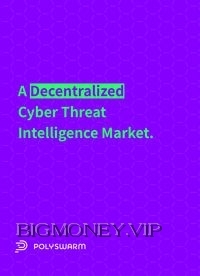
PolySwarm in 60 Seconds
Polyswarm is a decentralized threat intelligence market
made possible by Ethereum smart contracts and blockchain
technology.
Polyswarm incentivizes rapid innovation in the $8.5B/yr anti-virus and
automated cyber threat intelligence space with precise economic incentives that
reward timely and accurate threat intelligence concerning the malintent of files,
network traffic and URLs.
PolySwarm defines a real-time threat detection ecosystem involving
enterprises, consumers, vendors and geographically-diverse security
experts. Experts develop and hone competing “micro-engines” that
autonomously investigate the latest threats, attempting to outperform
their competition. PolySwarm’s “Proof of Work” is threat detection
accuracy: the market rewards experts who are best able to defend
enterprises and end users.
Relative to today’s ad hoc market, PolySwarm will lower the barrier
to entry, provide broader coverage options, discourage duplicative
effort and ensure interoperability among products and threat
intelligence feeds.
Economically, PolySwarm functions as a skill-required twist on a
prediction market with thousands of micro-engines (“workers”)
investigating the latest in malware evolution at machine speed - no
human in the loop.
PolySwarm will be developed by PolySwarm Pte. Ltd. with funding
derived from the sale of ERC20-compatible Nectar (“NCT”) utility
tokens.
As a utility token, PolySwarm economically disincentivizes Nectar
speculation by rewarding honest market participation through the
collection and distribution of Fees (details on page 6) to valueadding, active participants.
Background
Today’s enterprises rely on an ad-hoc mixture of anti-virus subscriptions,
threat intelligence feeds, and assorted dynamic analysis engines to defend
against evolving adversarial cyber activity. Users must weigh the benefits and
drawbacks presented by each solution and decide on the least-worst fit for
their environment.
Today’s market discourages solutions that provide broad threat
coverage.
Today’s solutions focus on a comfort zone of threats - a direct
result of today’s market economics.
It’s easy (and perhaps justifiable) to ignore an anti-virus solution
that doesn’t detect WannaCry, but in doing so, today’s market
effectively rewards overlapping coverage among vendors - a market
inefficiency that causes duplicative cost. This is a classic tragedy of
the commons situation.
Similarly, consider a vendor that chooses to develop expertise outside
of this comfort zone. If the comfort zone is defined by the set of
threats faced by most enterprises, sales for this specialized vendor
will be difficult. How do you convince a potential customer that they
Polyswarm. A Decentralized Cyber Threat Intelligence Market.




